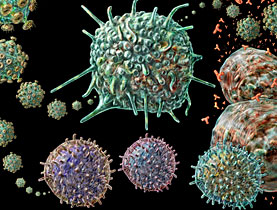Study finds Aids treatment gap is closing

Research into Aids treatment has shown that drugs used in Switzerland are equally successful in South Africa - one of the epidemic's worst hit areas.
While the study, published in the online journal PLos Medicine on Tuesday, is a vote of confidence for the standardised drug treatments South Africa provides to its millions of patients, the authors also call for greater efforts to be made to ensure people are diagnosed and treated earlier.
The World Health Organization backed the study, saying it showed drugs in use were starting to close the “treatment gap between rich and poor countries”.
The universities of Bern and Cape Town compared treatment patterns in two South African townships and among patients at the Swiss HIV Cohort Study from 2001 onwards.
They discovered that patients responded similarly to antiretroviral therapy (ART), which inhibits the replication of HIV, in use in both countries.
“You get similar results in the treatment of antiretroviral therapy in Switzerland and South Africa, at least in the short term, even though in South Africa they have much fewer treatment options available,” Olivia Keiser, one of the authors of the study, told swissinfo.
“It could still be different over the long term. At least now the treatment outcome seems really good.”
Quick treatment
The study compared viral responses, changes to different treatments and mortality in patients who all began by following the highly active antiretroviral therapy (HAART) in South Africa and Switzerland.
Provided the 2,348 South African patients were treated early enough, the outcome was virtually the same as the 1,016 sufferers being monitored at the Swiss HIV Cohort Study, a clinical epidemiological research project running since 1987.
In both countries, the viral level in blood was considerably reduced within a year in almost all patients, and a viral resurgence was witnessed within two years in a quarter of patients.
One main difference was a higher mortality rate in South Africa, especially in the first three months, which the study attributed to sufferers seeking treatment at an advanced stage of the disease.
“What is quite striking is that patients come really late to the clinics. It is much more frequent in South Africa, they start with a high degree of immunodeficiency compared to Switzerland,” Keiser said. “Quick treatment is important.”
She said Switzerland had many different ART treatments on offer – the patients could choose from 36 regimen compared to four in South Africa – and added that officials should even consider harmonizing some of the approaches.
The study concluded that a standardized and simplified approach was no less effective for patients.
Early diagnosis
Marco Antônio de Ávila Vitória, of the World Health Organization’s Department of HIV/Aids, said the study showed the encouraging outcome of treating HIV positive patients with ART, a method it currently promotes.
“It certainly is an additional and important contribution to the growing evidence that successful experiences like this observed in Cape Town, has been pivotal in unlocking the treatment agenda, and starting to close the treatment gap between rich and poor countries.”
But he expressed concern that patients from South Africa were starting therapy too late.
“That is the reason why an earlier diagnosis and timely initiation of ART, using such simple, standardised and evidence based approaches is likely to be the only way countries like South Africa are likely to reach the ambitious global goals of universal access [to ART].”
swissinfo, Jessica Dacey
Public Health and Individual Approaches to Antiretroviral Therapy: Township South Africa and Switzerland Compared was prepared in collaboration with the Institute of Social and Preventive Medicine at Bern University, the Desmond Tutu HIV Centre at the University of Cape Town, Bristol University, Médecins Sans Frontières, Bern University Hospital, and Zurich University Hospital.
The study looked at townships in Cape Town using the highly active antiretroviral therapy (HAART) programme, which is characterised by a limited form of treatments and standardisation of clinical and laboratory monitoring.
In industrialised countries doctors prescribe from the full range of available antiretroviral drugs, supported by resistance testing and frequent laboratory monitoring.
The study compared viral responses, changes to different regimens and mortality in patients starting HAART in South Africa and Switzerland.
Number of people living with HIV in 2007 – 33.2 million
AIDS deaths in 2007 – 2.1 million
Sub-Saharan Africa – 22.5 million adults and children living with Aids
South and South-East Asia – 4.0 million
Eastern Europe and Central Asia – 1.6 millon
Latin America – 1.6 million
North America – 1.3 million
East Asia – 800 000
Western and Central Europe – 760 000
Middle East and North Africa – 380 000
Caribbean – 230 000
Oceania – 75 000
– Source UN Aids December 2007
WHO says that by adopting ART countries will be able to treat more people and increase efforts to prevent HIV transmission.
To help countries increase their national HIV/AIDS responses WHO recommends HIV testing and counselling, accelerating the access to HIV/AIDS treatment, and strengthening public health systems.

In compliance with the JTI standards
More: SWI swissinfo.ch certified by the Journalism Trust Initiative












You can find an overview of ongoing debates with our journalists here . Please join us!
If you want to start a conversation about a topic raised in this article or want to report factual errors, email us at english@swissinfo.ch.